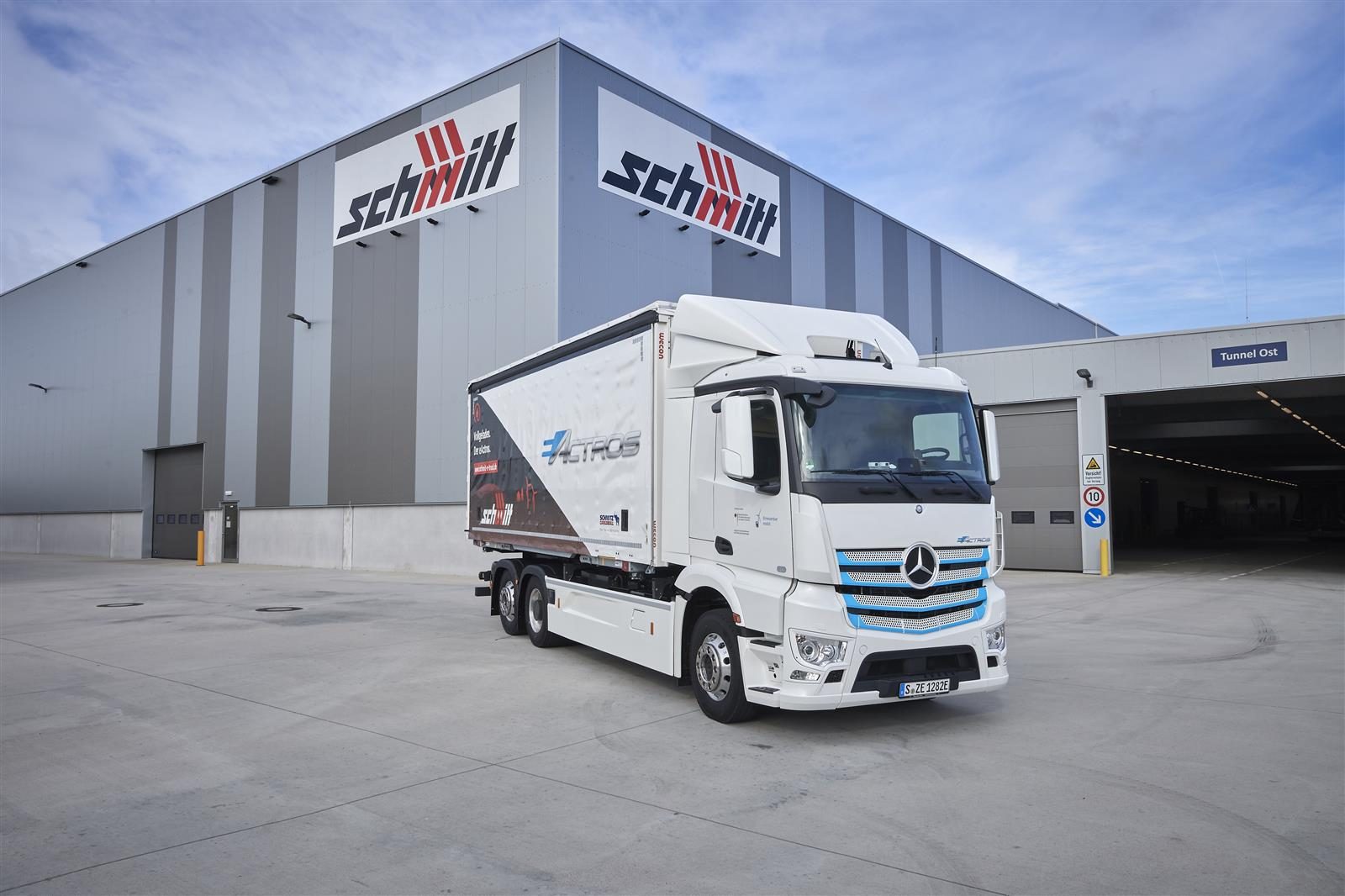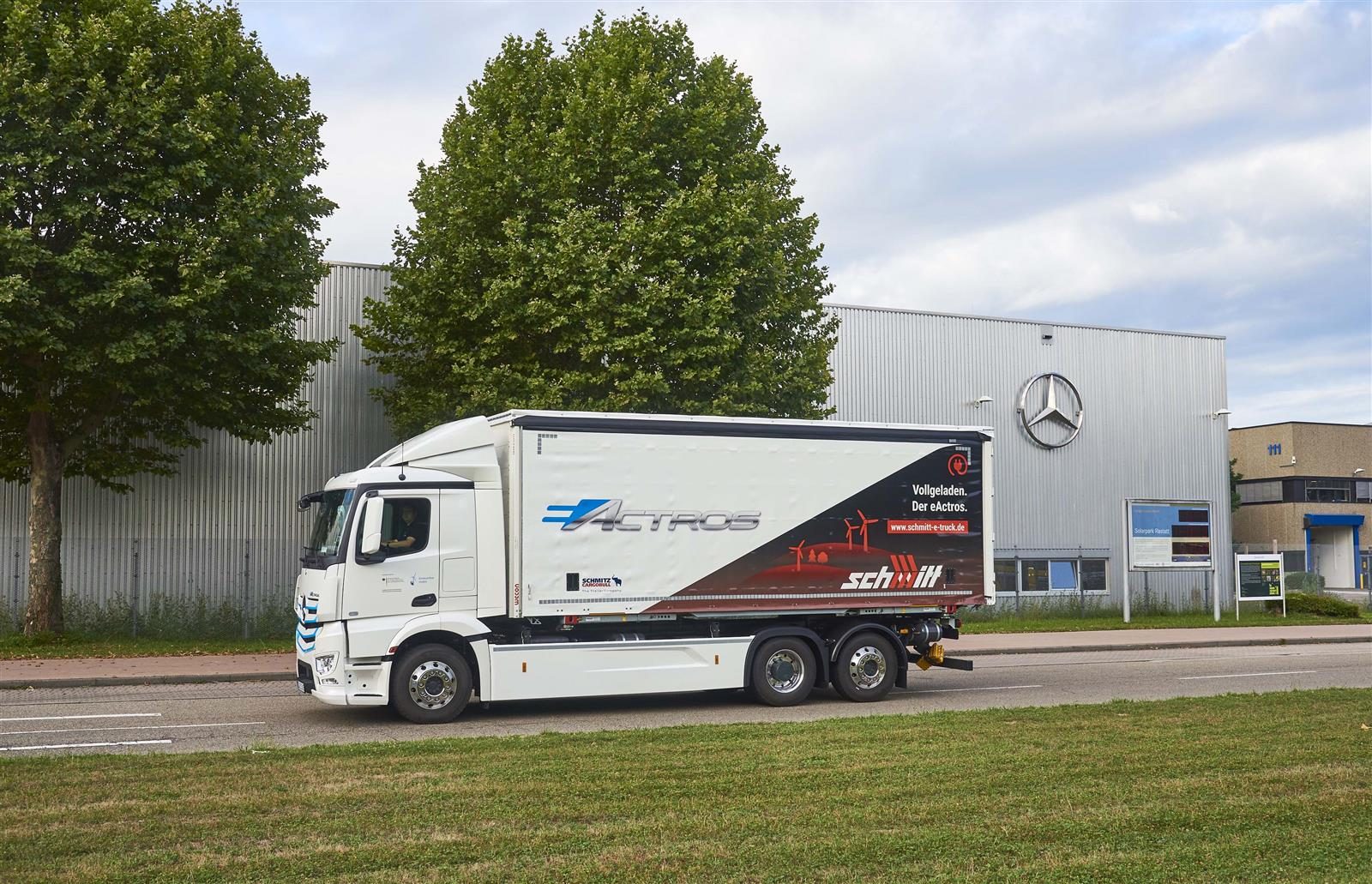Fully electric heavy-duty Mercedes-Benz eActros in practical testing

The battery electric Mercedes-Benz eActros is in operation at logistics company Logistik Schmitt, located near Rastatt in southern Germany. Practical testing of the all-electric heavy-duty truck has been carried out in the region over the course of several years now and, as part of this, comparative drives with the eWayBW catenary project are also planned to take place in the Murg valley and surrounding areas. The official handover of the eActros to Logistik Schmitt took place at the beginning of the year as part of the Daimler Trucks annual press conference in Gaggenau.
The 25-tonne vehicle commutes between the warehouse facility of Logistik Schmitt in Ötigheim and Rastatt’s Mercedes-Benz Gaggenau plant approximately seven kilometres away. Logistik Schmitt uses the eActros instead of a conventional diesel truck for the transportation of transmission housings. In doing so, the eActros with its range of up to 200 kilometres, covers a daily distance of approximately 168 kilometres as part of a demanding three-shift operation.
“The Mercedes-Benz eActros is now integrated into daily operations by our test customers in Germany and Switzerland,” says Stefan Buchner, head of Mercedes-Benz Trucks. “Here, the eActros has already covered tens of thousands of kilometres. Even fully loaded and regardless of hot or cold temperatures, it successfully completes its daily duties. This spurs us on in our aim to enable locally emission-free distribution with heavy-duty, series-produced trucks from 2021onwards. We are pleased that, together with Logistik Schmitt, we are able to further expand the testing of the eActros. We will also take the findings of this testing phase and apply them as part of the comparative drives planned with the eWayBW catenary project. First positive feedback from Logistik Schmitt has left us very optimistic.”
Rainer Schmitt, executive partner of Logistik Schmitt, says the eActros is well suited for use in distribution operations like theirs.
“In close collaboration with the experts at Mercedes-Benz Trucks, we clarified key questions concerning the scope of our operations and the required charging infrastructure. When we started using the eActros, our drivers also received a comprehensive training course and instructions as to how to operate the electric truck. The eActros now transports as much as 12 tonnes of freight and drives 12 tours on a daily basis, thereby covering a total of 168 kilometres. It is charged using a mobile charging station at our own premises in between the individual tours whilst unloading and loading takes place.”

As part of the eWayBW project, the transport of goods on the B462 near Rastatt will be partially electrified, whereby diesel-hybrid catenary trucks will be tested. In parallel to this, tests of the eActros will take place by way of comparison with the catenary project. As part of this testing, a further-developed version of the eActros with higher payload capacity and greater range will be used.
Using the further-developed version of the eActros, Logistik Schmitt will also deliver axle components along the 14 kilometres from the warehouse in Ötigheim to the Mercedes-Benz plant in Gaggenau – mainly via the B462. This route is, for the most part, the same as that used for the catenary truck project. The specifications of the eActros will be comparable with those of the catenary truck. This parallel testing of the eActros and the catenary trucks will take place for around one year and will deliver the most important data and findings necessary for comparing both concepts and its use cases.
There will also be a direct comparison with the catenary truck. Here, the eActros will spend around one to two weeks driving the exact route of the catenary project truck. This will serve to validate the second phase. During this direct comparison, the eActros will transport rolls of paper the 18 kilometres from the paper mill in Gernsbach-Obertsrot to the Fahrner logistics site in Kuppenheim – just like the trucks involved in the overhead-lines project.
A conventional diesel Actros equipped to the Euro 6 emissions standard and fitted with measuring equipment will serve as a neutral starting point for the comparison of the concepts and will drive along the overhead-lines route. It will then be possible to compare the energy consumption of the electric trucks – battery-electric and catenary – with the consumption of the diesel truck.
As a global manufacturer, Daimler is working on future-oriented solutions that have great potential for worldwide implementation. Due to the high infrastructure costs involved, the company does not see potential in overhead lines at present – also in view of the rapid development of battery and fuel cell technology.





